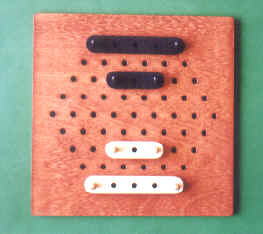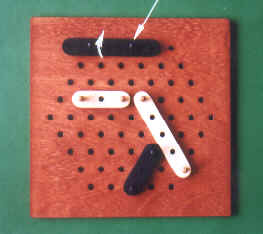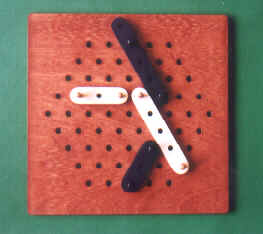The
invention
- The
problem to be solved:
How to move board game-pieces as rotating
elements around changeable axes of
rotation.
|
- Definition:
The bore-holes on the rotating
elements of the logical board game are
matched with equidistant holes. Moving of
the rotating element is carried out by
rotating it around a peg, which serves as
an axis of rotation. The said peg is
transposable at each move as the strategy
of the game dictates.
|
- Presentation:
The logical board game, in the
form as it will be exhibited, is only one
possible embodiment of the invention. It
is played by two players, each of them
having two rotating elements, and it uses
a board equipped with holes. The centers
of the holes form a net of points
consisting of isosceles triangles on a
field of a regular hexagon. One player
has 1 rotating element with 3 holes, and
one rotating element with 5 holes. The
holes are positioned along a straight
line, and they are spaced according to
the distance between the points of the
said net on the board. Each rotating
element is oriented on the board by 2
pegs, which pass through its holes. The
distance between its holes is identical
with the distance between the holes of
the board. The pegs fit into the holes of
the board with slight friction, while
they fit into the holes of the rotating
elements loosely, with a little
clearance. The center-lines of the rows
of the holes intersect each other at 60
degree angle on the board at each hole.
Consequently, if a hole as a place of
axis of rotation is not situated at the
edge of the hexagon-shaped field, the
rotating element can be rotated in 6
directions that its own row of holes will
be superpositioned over at least one of
the holes of the board. This net-system
ensures the maximum number of
correspondence between the holes of the
rotating elements and the orientating
holes of the board in the course of a
complete 360 degree turning: Every hole
is equidistant from its neighbor. One of
the players has white, the other has dark
pegs and rotating elements. The starting
position of the game is shown in Fig. 1.
White begins the game, then the players
take turns. One can move with any of his
own rotating elements, even if it was
used previously. Moves are made in the
following way. Using one of the pegs as
an axis of rotation, rotate the selected
element (in either clockwise or a counter
clockwise direction) around the peg
inserted into a board hole through one of
the holes of the rotating element.
Position it over one of the 6 possible
rows of holes, which are 60 degrees
apart, and affix it with the other peg
using any of the free holes. During
rotation none of the holes of the
rotating element can get closer to any
hole of another rotating element than one
hole-distance. This rule has only
theoretical significance, because the
rotating elements are fashioned in such a
manner that a bad move is prevented by
collision. During or after rotation, a
part of the rotating element may extend
beyond the borders of the net or that of
the board. However, once the rotation is
complete, at least two of the holes of
the rotating element must be above the
holes of the board for correct affixing.
Applying a 360 degree rotation, the
rotating element can be rotated back to
the starting position. This may make
sense when the player does not want to
lose his advantageous position, and wants
to force his opponent to move, in order
to make him vulnerable. The goal of the
game is to create a situation when the
relationships between the rotating
elements, according to the defined rules,
can be interpreted as victorious. More
specifically, a player wins if his
opponent cannot move with one of his
rotating elements.
  
Fig. 1:The
starting position of the game
This peg will be the axis of rotation |
Fig. 2:This is the
position of rotating elements before
the victory of black |
Fig. 3:The white
rotating element (with 5 holes) is
unable to move |
|
- Application:
The board game derived from the invention
excels at developing logical thought
processes, and lays the foundation of the
development of a new breed of competitive
mental sports.
|
- Advantages:
The number of possible moves illustrates
the extraordinary variability of this
game. If the rotating element is
positioned properly, and there are no
other elements blocking its path, then
there are 2 starting directions, 2
directions of rotation, 6 ending
positions, and depending on the size of
the rotating element, 3 or 5 axes of
rotating (3 or 5 holes), as the choices
for the next move can be made. Before a
move we have to consider the possible
moves of all rotating elements, perhaps
even for multiple moves ahead.
Consequently, a thorough analysis can
become a very complex task. The versatile
and astonishing movement patterns of the
rotating elements give aesthetic
pleasure, and the analyses of the complex
positions as they develop on the board
make this invention an enjoyable,
chess-quality game. If the rotating
elements are made of hinged members, and
the joints are fashioned to correspond to
the positions of the holes of the
elements, new colors and possibilities
enter into the game.
|
- Stage
of development: Product
|
- Documentation
available: Yes
|
| The
inventor(s)

- Self
introduction:
The inventor is a certified mechanical
engineer, and works as a precision
mechanical constructor. He holds 30
international patents, among which 5 of
them are U.S.A. patents. He has received
numerous accreditations for several
different inventions. He holds 2 gold, 2
silver, and 2 bronze medals from various
world exhibitions of invention.
|
The
protection
- Form:
Exhibition priority
- Priority: 04.05.2000.
- Countries
where it is force:
|
Business
intention: Product and invention are
available for sale or license.
|
Contact
- Name:
József VADÁSZ
- E-mail:
- Phone: +361- 417 3703
- Address: H-1154 Wesselényi utca 58., Hungary
|
|